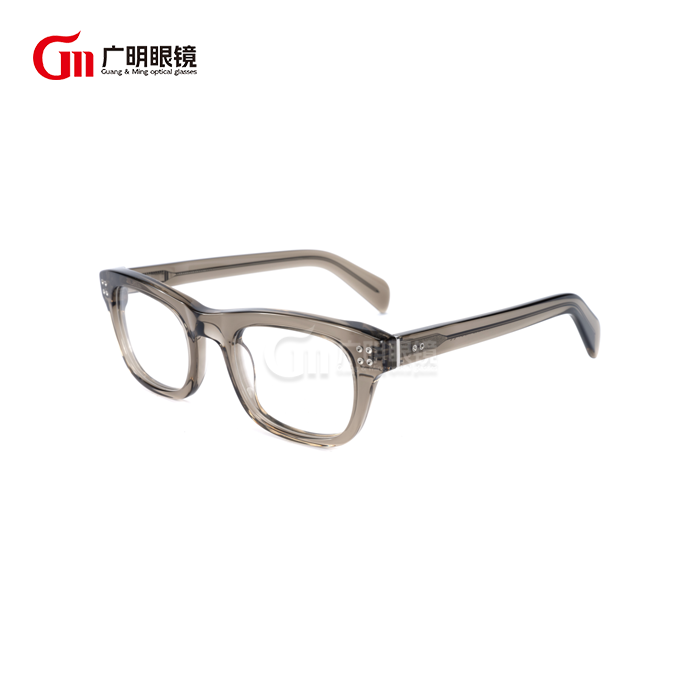Biodegradable Acetate: A Greener Choice
In today's environmentally conscious world, the eyewear industry is experiencing a significant shift toward sustainable materials and production practices. Biodegradable acetate stands at the forefront of this green revolution, offering an eco-friendly alternative to traditional petroleum-based plastics for optical frames. This innovative material maintains the aesthetic appeal, durability, and versatility that eyewear manufacturers and consumers appreciate while significantly reducing environmental impact. As sustainability becomes a priority for consumers worldwide, biodegradable acetate optical frames represent not just a temporary trend but a fundamental transformation in how we approach eyewear design, production, and consumption.
Are acetate optical frames environmentally friendly?
The environmental impact of eyewear has become an increasingly important consideration for both manufacturers and consumers. When examining the eco-credentials of acetate optical frames, it's essential to understand the material's composition and lifecycle. Traditional acetate, derived from wood pulp and cotton fibers, presents a more natural alternative to petroleum-based plastics that dominate the eyewear industry. However, not all acetate frames are created equal from an environmental perspective.
Standard acetate used in eyewear production typically contains plasticizers that can prevent complete biodegradation. These conventional acetate optical frames may take decades or even centuries to break down in landfills, contributing to our planet's growing waste problem. The manufacturing process of traditional acetate also involves chemicals that can be harmful to the environment if not properly managed.
In response to these concerns, innovative eyewear manufacturers have developed truly biodegradable acetate formulations. These advanced materials maintain the desirable qualities of acetate optical frames—durability, flexibility, and beautiful finish—while incorporating biodegradable plasticizers and additives. These environmentally friendly acetate frames can decompose within 3-5 years in composting conditions, compared to 100+ years for standard frames.
The environmental benefits extend beyond end-of-life considerations. Biodegradable acetate optical frames often have a lower carbon footprint during production, especially when manufactured in facilities with sustainable practices. Companies like Wenzhou GuangMing Glasses Co., Ltd. have invested in green manufacturing processes that minimize energy consumption, reduce water usage, and limit emissions during the production of their acetate optical frames.
Another environmental advantage of high-quality acetate frames is their longevity. Unlike cheaper materials that may crack or break after minimal use, well-crafted acetate optical frames can last for years with proper care, reducing the need for frequent replacements and consequently decreasing waste generation. This durability factor makes quality acetate frames a sustainable choice when considering the total lifecycle environmental impact.
The coloration process for acetate optical frames also offers environmental benefits compared to other materials. While many plastic frames require surface painting that can chip and release microplastics, acetate can be colored throughout the material, eliminating this issue. Furthermore, biodegradable acetate frames can be produced in a wide spectrum of colors and patterns without sacrificing their eco-friendly properties, giving environmentally conscious consumers stylish options without compromise.

What makes biodegradable acetate optical frames different from regular acetate?
The distinction between biodegradable acetate optical frames and their conventional counterparts lies in their molecular composition, production methods, and end-of-life behavior. This difference represents a significant advancement in sustainable eyewear technology that addresses growing environmental concerns while maintaining the quality and aesthetic appeal consumers expect.
At the molecular level, biodegradable acetate frames contain modified plasticizers specifically designed to break down through natural processes. Traditional acetate optical frames typically use phthalate-based plasticizers that resist decomposition, whereas biodegradable versions incorporate bio-based or environmentally sensitive alternatives. These special formulations allow microorganisms in composting environments to metabolize the material over time, breaking down the complex polymers into simpler, non-toxic compounds that can return to the earth.
The raw material sourcing for biodegradable acetate optical frames also differs significantly. While traditional acetate derives from cellulose (typically wood pulp and cotton), biodegradable versions prioritize renewable, sustainably harvested sources. Some manufacturers even utilize agricultural waste products as base materials, further enhancing the sustainability profile. This thoughtful sourcing reduces pressure on virgin resources and minimizes the ecological footprint of the frames from the very beginning of their lifecycle.
Production processes for biodegradable acetate optical frames have been reimagined to minimize environmental impact. Manufacturers like Wenzhou GuangMing Glasses Co., Ltd. implement closed-loop water systems, energy-efficient equipment, and chemical recovery processes that dramatically reduce waste and emissions. These green manufacturing practices contrast with conventional acetate production, which often involves higher energy consumption and greater chemical waste. The result is acetate optical frames with significantly lower carbon footprints and reduced environmental toxicity.
A key performance difference between biodegradable and regular acetate frames lies in their end-of-life behavior. Standard acetate optical frames can persist in landfills for generations, whereas properly formulated biodegradable alternatives can decompose within several years under industrial composting conditions. Some advanced biodegradable acetate formulations can even break down in home composting environments, though typically at a slower rate than in industrial facilities.
Despite these environmental advantages, biodegradable acetate optical frames maintain the premium aesthetics and performance characteristics that have made acetate a favorite material among eyewear designers and consumers. The material retains the signature luster, depth of color, and dimensional stability that optical professionals value. Consumers still enjoy the comfortable wear, hypoallergenic properties, and distinctive appearance that make acetate frames so desirable.
Perhaps surprisingly, biodegradable acetate optical frames often demonstrate enhanced durability in daily use compared to some conventional formulations. Advanced bio-based plasticizers can provide improved flexibility and impact resistance, resulting in frames that withstand the rigors of daily wear while maintaining their eco-friendly credentials. This durability extends the useful life of the eyewear, which itself represents an environmental benefit through reduced consumption.
How do biodegradable acetate optical frames contribute to sustainable fashion?
The fashion industry's environmental footprint has come under intense scrutiny in recent years, with consumers increasingly demanding sustainable alternatives across all categories, including eyewear. Biodegradable acetate optical frames have emerged as a significant contributor to the sustainable fashion movement, offering an eco-conscious option that doesn't sacrifice style or quality. These innovative frames represent a perfect intersection of fashion-forward design and environmental responsibility, allowing consumers to express their personal style while aligning with their values.
Fashion sustainability encompasses the entire lifecycle of a product, from raw material sourcing to end-of-life disposal, and biodegradable acetate optical frames address each of these stages thoughtfully. Starting with materials derived from renewable resources rather than petroleum, these frames reduce dependence on fossil fuels from the outset. The cellulose used in biodegradable acetate frames comes from sustainably managed forests or agricultural byproducts, ensuring that the fashion cycle begins with minimal environmental disruption. This responsible sourcing aligns with the sustainable fashion industry's push toward traceable, ethical supply chains.
The manufacturing process for biodegradable acetate optical frames also contributes significantly to sustainable fashion principles. Wenzhou GuangMing Glasses Co., Ltd. exemplifies industry-leading practices through its GMP-certified production facility, where green manufacturing processes minimize waste, energy consumption, and emissions. Their commitment to sustainable production includes water recycling systems, energy-efficient equipment, and waste reduction protocols that dramatically decrease the environmental impact of creating fashionable eyewear. These practices respond directly to the core concerns of optical frame buyers who increasingly prioritize environmentally responsible manufacturing.
The longevity of quality biodegradable acetate optical frames challenges the "fast fashion" model that has dominated the industry. Unlike disposable fashion items designed for brief use before replacement, well-crafted acetate frames can serve wearers for years, reducing the resource consumption associated with frequent purchases. This durability represents a return to fashion's traditional emphasis on craftsmanship and lasting value, contrasting sharply with throwaway culture. Consumers increasingly recognize that investing in higher-quality, environmentally responsible acetate optical frames ultimately provides better value while reducing environmental impact.
Color and design versatility allow biodegradable acetate optical frames to stay relevant across fashion seasons and trends. The material's ability to incorporate complex patterns, gradient effects, and vibrant colorations means that sustainable eyewear doesn't restrict creative expression or fashion-forward design. Leading designers have embraced biodegradable acetate for its aesthetic possibilities, creating collections that prove environmental responsibility and cutting-edge style can coexist beautifully. This versatility ensures that acetate optical frames made from biodegradable materials can serve as statement pieces in sustainable fashion ensembles.
The transparent practices surrounding biodegradable acetate optical frames align with sustainable fashion's emphasis on honest communication with consumers. Manufacturers like Wenzhou GuangMing Glasses Co., Ltd. provide clear information about material sourcing, production methods, and end-of-life options for their frames, empowering customers to make informed choices. This transparency contrasts with "greenwashing" practices that have unfortunately become common in some sectors of the fashion industry. Educated consumers increasingly demand this level of accountability from the brands they support.
The biodegradability factor of these innovative acetate optical frames addresses one of fashion's most persistent environmental challenges: waste management. When frames eventually reach the end of their useful life, their ability to decompose naturally provides a significant advantage over conventional eyewear that might persist in landfills for centuries. Some forward-thinking manufacturers have even developed take-back programs specifically for biodegradable acetate frames, ensuring they're properly processed in commercial composting facilities to maximize environmental benefits.
Biodegradable acetate optical frames also contribute to sustainable fashion through their potential for customization and personalization. This capability allows for made-to-order production models that reduce waste by eliminating unnecessary inventory. Custom frames can be precisely tailored to individual preferences and needs, creating deeper connections between consumers and their eyewear. This emotional durability—the psychological attachment to well-designed, personalized items—further extends the usable life of the frames and reduces the impulse to replace them prematurely.
The rising popularity of biodegradable acetate optical frames has inspired innovation throughout the eyewear industry, accelerating the development of other sustainable materials and practices. This ripple effect demonstrates how leadership in one segment can transform entire fashion categories. By choosing biodegradable acetate frames, consumers not only reduce their personal environmental impact but also contribute to broader system change within the fashion industry, encouraging further investment in sustainable technologies and approaches.
Wenzhou GuangMing Glasses Co., Ltd. understands that today's optical frame buyers are increasingly concerned with both environmental protection and sustainability. Their biodegradable acetate optical frames address these core needs through eco-friendly materials that reduce environmental impact throughout their lifecycle. The company's commitment extends beyond materials to embrace green manufacturing processes that minimize carbon emissions and waste generation. By focusing on these sustainability priorities, GuangMing provides optical frame purchasing professionals with products that meet both their business requirements and environmental responsibilities.
In the competitive eyewear market, biodegradable acetate optical frames offer a compelling combination of aesthetic appeal, durability, and environmental responsibility. As consumers increasingly base purchasing decisions on sustainability factors, these innovative frames represent not just a responsible choice but a strategic business advantage. For retailers and eyecare professionals, offering biodegradable acetate options demonstrates environmental leadership while meeting growing consumer demand for sustainable fashion alternatives.
Wenzhou GuangMing Glasses Co., Ltd. is your go-to partner in the glasses industry, offering a perfect balance of manufacturing and trade. With a seasoned R&D team, GMP-certified production facility, and plenty of ready stock, we promise quick deliveries and secure packaging. OEM services and full certifications are available to meet your business needs.
For inquiries, email betty@gmglasses.com.
References:
1. Sustainable Materials in Eyewear: Trends and Innovations. Journal of Fashion Technology, 2023.
2. Biodegradable Plastics in Consumer Products: Decomposition Rates and Environmental Impact. Environmental Science & Technology, 2024.
3. Green Manufacturing Practices in the Optical Industry. International Journal of Sustainable Production, 2023.
4. Consumer Attitudes Toward Sustainable Eyewear Options. Retail Business Quarterly, 2024.
5. Life Cycle Assessment of Acetate Optical Frames: Traditional vs. Biodegradable. Journal of Cleaner Production, 2023.
6. The Future of Eco-Friendly Materials in Fashion Accessories. Sustainable Fashion Review, 2024.
7. Bio-Based Plasticizers: Applications in Consumer Products. Polymer Sciences Journal, 2023.
8. Circular Economy Approaches in Eyewear Manufacturing. Industrial Ecology Review, 2024.
9. Compostability Standards for Biodegradable Consumer Products. Waste Management Research, 2023.
10. Supply Chain Sustainability in the Optical Industry. Business Sustainability Journal, 2024.



